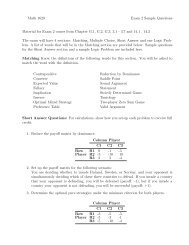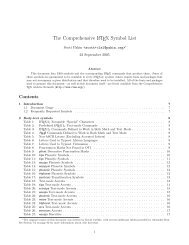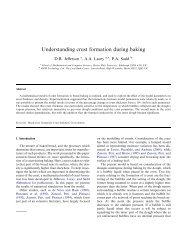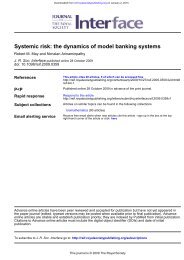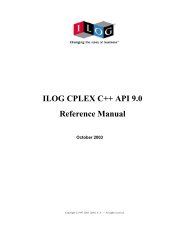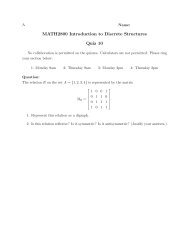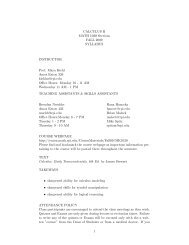MATH 6620: Introduction to Perturbation Methods Spring 2004
MATH 6620: Introduction to Perturbation Methods Spring 2004
MATH 6620: Introduction to Perturbation Methods Spring 2004
Create successful ePaper yourself
Turn your PDF publications into a flip-book with our unique Google optimized e-Paper software.
<strong>MATH</strong> <strong>6620</strong>: <strong>Introduction</strong> <strong>to</strong> <strong>Perturbation</strong> <strong>Methods</strong><br />
<strong>Spring</strong> <strong>2004</strong><br />
<strong>Perturbation</strong> methods involve a systematic construction of approximate solutions <strong>to</strong> mathematical problems<br />
which are otherwise intractable. These methods rely on there being a parameter in the problem that<br />
is relatively small. Small parameters commonly appear in a broad range of natural and technological applications<br />
including, but not limited <strong>to</strong>, mechanics, population dynamics, solid mechanics, fluid mechanics,<br />
aerodynamics, electrodynamics, wave propagation, de<strong>to</strong>nation theory, chemical reac<strong>to</strong>rs, heat transfer, combustion,<br />
biological sciences, celestial mechanics, optics, shock waves, and nonlinear oscilla<strong>to</strong>rs. By taking<br />
advantage of a small parameter and/or disparate scales in a system, a complicated problem can be replaced<br />
by a series of simpler solvable ones. The simpler problems can be solved one by one <strong>to</strong> obtain an<br />
increasingly accurate approximation <strong>to</strong> the true solution. Though solutions can typically be computed numerically,<br />
analytical approximations of solutions often provide physical insight in<strong>to</strong> the solution behavior<br />
and its dependence on the control parameters.<br />
Instruc<strong>to</strong>r: Chris Wahle (Amos Ea<strong>to</strong>n 412, wahlec@rpi.edu)<br />
Office Hours: Thursday 11:00-1:00pm, or by appointment<br />
Webpage: ea<strong>to</strong>n.math.rpi.edu/faculty/Wahle/Courses/<strong>6620</strong>/website/home.html<br />
Suggested References: The first three textbooks listed should be at the RPI books<strong>to</strong>re.<br />
• Advanced Mathematical <strong>Methods</strong> for Scientists and Engineers, C.M. Bender<br />
and S.A. Orszag, <strong>Spring</strong>er-Verlag, ISBN: 0387989315, Amazon cost: $65.00.<br />
• <strong>Introduction</strong> <strong>to</strong> <strong>Perturbation</strong> <strong>Methods</strong>, M. Holmes, <strong>Spring</strong>er-Verlag, ISBN: 03879<br />
42033, Amazon cost: $64.95.<br />
• Multiple Scale and Singular <strong>Perturbation</strong> Theory, J. Kevorkian and J.D. Cole,<br />
<strong>Spring</strong>er-Verlag, ISBN: 0387942025, Amazon cost: $82.95.<br />
• <strong>Perturbation</strong> <strong>Methods</strong> in Applied Mathematics, J. Kevorkian and J.D. Cole,<br />
<strong>Spring</strong>er-Verlag, ISBN: 3540905073, Amazon cost: out of s<strong>to</strong>ck.<br />
• <strong>Perturbation</strong> <strong>Methods</strong> in Fluid Dynamics, M. Van Dyke, Parabolic Press Inc.,<br />
ISBN: 0915760010, Amazon cost: $15.00.<br />
• <strong>Perturbation</strong> <strong>Methods</strong>, E.J. Hinch, Cambridge University Press, ISBN: 0521378974,<br />
Amazon cost: $26.00.<br />
• <strong>Perturbation</strong> <strong>Methods</strong>, A.H. Nayfeh, Wiley-Interscience, ISBN: 0471399175,<br />
Amazon cost: $69.95.<br />
• <strong>Introduction</strong> <strong>to</strong> <strong>Perturbation</strong> Techniques, A.H. Nayfeh, Wiley-Interscience, ISBN:<br />
0471310131, Amazon cost: $88.50.<br />
• <strong>Introduction</strong> <strong>to</strong> <strong>Methods</strong> of Applied Mathematics, Chapter 24, S. Mauch,<br />
No Copyright, Cost: FREE, download from the course webpage (∼ 1500 pages, 6.5 Mb).<br />
Grading: Grades will be based on homework (40%) and two take-home exams (30% each).
Topics<br />
1. Algebraic/Transcendental Equations<br />
(a) regular perturbation problems<br />
(b) scaling/balancing terms<br />
(c) singular perturbation problems<br />
2. Theory/Definitions/Terminolgy<br />
(a) order symbols, o and O<br />
(b) gauge functions<br />
(c) logarithmic expansions<br />
(d) asymp<strong>to</strong>tic sequences, series, and convergence<br />
3. Ordinary Differential Equations / Applications<br />
(a) regular perturbation problems<br />
(b) singular perturbation problems<br />
4. Matched Asymp<strong>to</strong>tic Expansions / Applications<br />
(a) boundary layer theory<br />
(b) outer/inner expansions<br />
(c) matching<br />
(d) interior layers<br />
(e) general theory<br />
5. Time Dilation and the Duffing equation<br />
(a) Poincaré-Lindstedt method of strained coordinates<br />
(b) Poincaré-Lighthill-Kao method of strained coordinates<br />
(c) renormalization<br />
(d) method of multiple scales (two-timing) for odes<br />
6. Partial Differential Equations<br />
(a) hyperbolic/parabolic/elliptic pdes<br />
(b) method of multiple scales<br />
(c) boundary layers<br />
7. Bifurcation and Stability Theory / Applications<br />
(a) linear stability analysis<br />
(b) bifurcations (transcritical, pitchfork, Hopf)<br />
(c) weakly nonlinear stability analysis<br />
8. Asymp<strong>to</strong>tic Integration<br />
(a) integration by parts<br />
(b) Laplace’s Integral Method<br />
(c) Watson’s Lemma
Other Potential Topics (time permitting)<br />
• homogenization<br />
• integral equations<br />
• method of averaging<br />
• slowly varying coefficients<br />
• eigenvalues/vec<strong>to</strong>rs<br />
• WKB/WKJB methods<br />
• Floquet theory and Mathieu’s equation<br />
• asymp<strong>to</strong>tics beyond all orders<br />
• intermediate layers / two-ply boundary layers<br />
• multiple scales: three-timing<br />
• asymp<strong>to</strong>tic integration<br />
– method of steepest decent<br />
– method of stationary phase<br />
• dynamical systems (systems of nonlinear odes)<br />
– equilibrium solutions (classification and stability)<br />
• miscellaneous applications, for example<br />
– correction <strong>to</strong> Kepler’s laws<br />
– large activation energy asymp<strong>to</strong>tics<br />
– thin films<br />
– nonlinear wave propagation<br />
– shocks<br />
– explosions<br />
– fluid flow<br />
– stability problems<br />
– etc.<br />
+ requests and suggestions


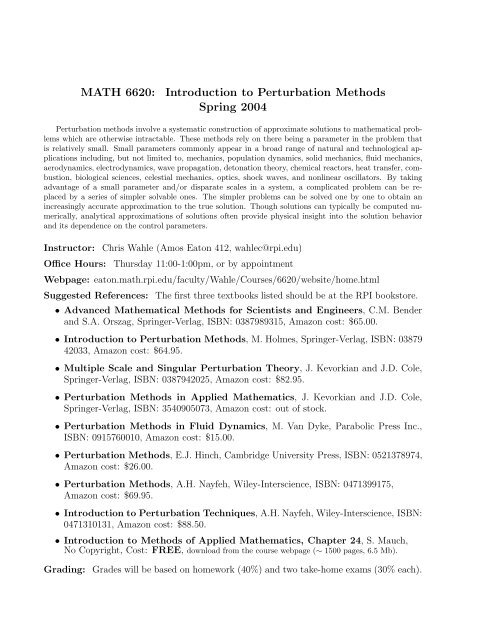
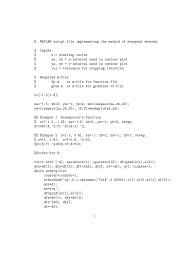

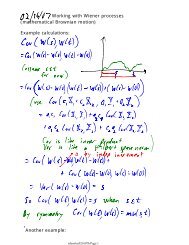

![MATH 1500 Sample Questions Exam 2 1. [3.7] A 10-ft plank is ...](https://img.yumpu.com/43861920/1/190x245/math-1500-sample-questions-exam-2-1-37-a-10-ft-plank-is-.jpg?quality=85)
